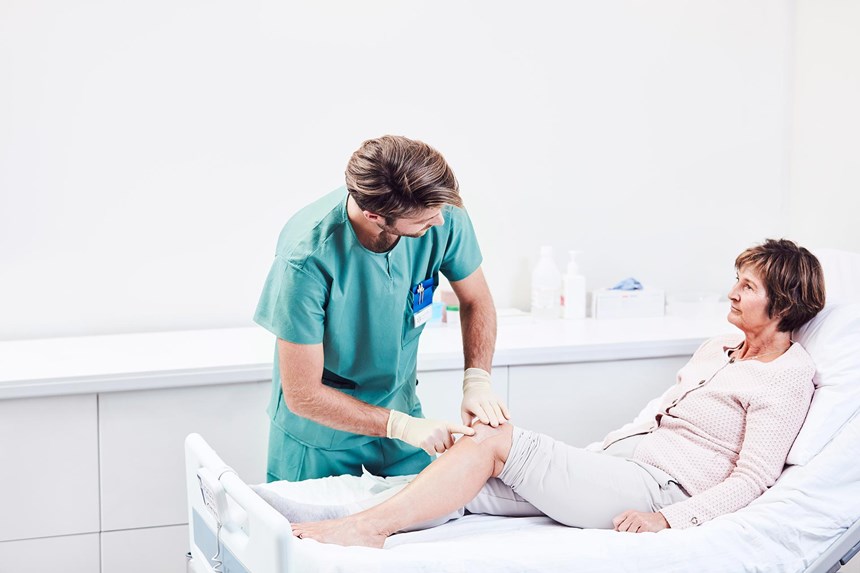Scar management
The soft silicone scar dressing Mepiform has been shown to improve the appearance of hypertrophic and keloid scars.

Scars are disfiguring and can interfere with the normal functioning of the skin and other organs affected. They are more likely to form where the primary cause of the scar persists, where there is continued inflammation and when the scar takes a long time to heal 1. Continued fibrosis in the skin leads to scarring and, potentially, disfigurement as a result of progressive deposition of matrix.
- Hypertrophic scars are seen in approximately 50 percent of wounds after surgery and more than 50 percent of healed deep burns. They are generally red, raised and itchy and appear within the boundaries of wounds.
- Keloid scars, although somewhat similar in appearance to hypertrophic scars, generally extend beyond the borders of the original scar: they affect all races but are 15 times more likely to occur in patients with darker skin. The incidence of keloid scars is about 10 percent in wounds in the high-risk groups.
- Contracture scars are particularly severe and usually occur as a result of losses of large areas of skin, e.g. following burn injuries, in epidermolysis bullosa and in badly aligned surgical wounds not corresponding to Langer’s lines. These scars cause the edges of the skin to pull together, affecting the adjacent muscles and tendons, thereby restricting normal movement and resulting, in some cases, in the need for z-plasty or skin grafting.
- Widened scars appear when surgical wounds are stretched as a result of skin tension during the healing process. They are generally pale in colour, flat, soft and symptomless, but can be aesthetically displeasing 1.
The role of soft silicone in scar management
Topical silicone gel sheeting has been used successfully for over 20 years to treat hypertrophic and keloid scars 2 and is supported by numerous clinical evaluations and international clinical recommendations on scar management 3.
Mepiform®, a soft silicone scar dressing with Safetac®, has been evaluated in a number of studies for the treatment of hypertrophic scars:
- Saulsberry et al 4 report on four cases where Mepiform was utilised for scar management following surgical incisions and burns. Throughout the treatment period (at least six months for each patient), the dressing maintained a low profile and remained in situ under a compression garment without edge roll or interfering with joint mobility. The scars, originally hyperpigmented, returned to a more normal pigmentation with a smoother and more flexible nature.
- Middelkoop et al 5 found the use of Mepiform was associated with a significant improvement in hypertrophic scars in a study involving 12 patients.
- In an observational study 6 undertaken to evaluate the effectiveness of Mepiform on post-burn and other traumatic scars of both pediatric and adult patients (n=87) in an outpatient setting, Cain et al found that Mepiform might help to enhance patient compliance, as well as improving scar quality and patient comfort.
- These findings are reflected in Forest-Lalande’s case study evaluation of Mepiform 7.
- In Majan’s randomised controlled trial 8 8 of 11 patients with postoperative hypertrophic scars, participants were randomly allocated to treatment with Mepiform or ‘left alone’. Patients treated with Mepiform showed greater and more rapid improvements than those in the non-treatment group, as measured by the Vancouver Scar Scale. Commenting on their results, the author conclude that, as Mepiform is self-adhesive and its use limits damage to the stratum corneum on removal, it gives it an added value compared with non-adhesive silicone gel dressings.
- In 2006, Meuleneire demonstrated how the early use of Mepiform prevented scarring of a severe forehead laceration in one patient 2.
- Philandrianos et al reported that Mepiform was used successfully to treat scars after breast operations 9
References
1. Meyer, F.J., Burnand, k.g., Abisi, S. et al. Effect of collagen turnover and matrix metalloproteinase activity on healing of venous leg ulcers. Br J Surg 2008; 95: 3, 319-325.
2. Meuleneire, F. Using a soft silicone dressing (Mepiform) to prevent scarring in an acute traumatic wound. Wounds UK 2007; 3: 4, 134-135.
3. Mustoe, T.A., Cooter, R.D., Gold, M.H. et al. International Advisory Panel on Scar Management. International clinical recommendations on scar management. Plast Reconstr Surg 2002; 110: 2, 560-571.
4. Saulsberry, C.M., Abney, S.b., landry, k.N. An evaluation of a new silicone dressing for the management of hypertrophic scars. Poster presentation at the 12th Symposium on Advanced Wound Care and Medical Research Forum on Wound Repair, Anaheim, California, United States of America, 1999.
5. Middelkoop, E., Van Uhen, E., Vloemans, J. The use of Mepiform silicone dressing as treatment for hypertrophic scars. Poster presentation at the European Wound Management Association conference, Stockholm, Sweden, 2000.
6. Cain, V.J., McMahon, L.R., O’Donnell, F.J. et al. Effectiveness of a silicone adherent dressing on post burn scar. Poster presentation at the American Burn Association conference, Boston, United States of America, 2001.
7. Forest-Lalande, l. Hypertrophic scar management: our experience with Mepiform dressing. Poster presentation at the 7th Annual Canadian Association of Wound Care conference, London, Ontario, Canada, 2001. hipocratico (primum non mocere); use apositos de silicona. Poster presentation at VII Simposio Nacional Úlceras por Presión y Heridas Crónicas, Tarragona, Spain, 2008.
8. Majan, J.l. Evaluation of a self-adherent soft silicone dressing for the treatment of hypertrophic postoperative scars. J Wound Care 2006; 15: 5, 193-196.
9. Philandrianos, C., Lavie, A., Perchenet, A.S., Magalon, G. Prise en charge des cicatrices mammaires post operatoires. Poster presentation at the 13eme Conference Nationale des Plaies et Cicatrisations, Paris, France, 2009.